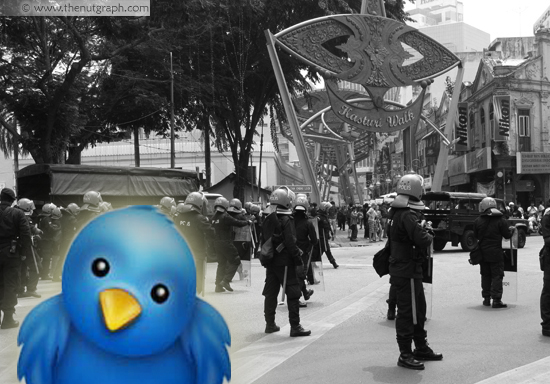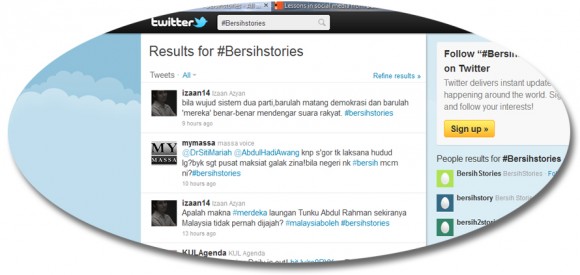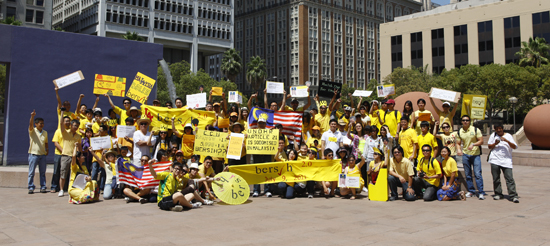IN the days before and after the Bersih 2.0 rally for electoral reform, Malaysian social networks were buzzing like never before. Internet chatter was centred around the biggest campaign in town: the street march in the heart of Kuala Lumpur on 9 July 2011.
Thanks to Facebook, Twitter and YouTube, users had a platform to share information in a continuous virtual conversation. This was a fundamental feature of the Bersih buzz online. There are variations in each of these social media platforms. Facebook allows lengthier exchanges, while Twitter provides quick updates on the go. YouTube allows users to share videos. The combination of these three was a powerful tool to garner support for as well as to vehemently criticise Bersih.

For an idea of just how much content was generated around the theme of Bersih, an ingenious website www.politweet.org tracked tweets on Twitter and the number of users one month before and one month after the rally. It recorded 263,228 tweets by 33,940 users using the #bersih hashtag between 9 June and 14 Aug. Even now, tweets about the topic are still being sent.
There are three main themes from examining the use of social media in the context of Bersih 2.0. One is the creation of a virtual common space for “socialising”, conversation and debate. Two, social media allowed contradictory reports to be verified. And three, polarities between users were made more apparent.
Common space
First, living up to being “social”, Facebook and Twitter created common spaces for users. They formed and shaped identity by allowing users to label themselves for identification and association. Proponents of Bersih were able to easily separate “friends” from “enemies” with the use of PicBadges on profile pictures. All it took was a click to categorise yourself socially.
Activists made use of Twitter themes to snowball responses, like “why #bersih” for users to give their reasons for supporting Bersih, or to lobby local politicians with the #tanyanajib hashtag, questioning the prime minister‘s commitment to reform. Tweets and responses were humourous, witty, sarcastic, and at times highly emotional as people lashed out against each other. This is an interesting sub-theme which I return to later.
A spirit of camaraderie built up in the two weeks leading to the actual event, culminating in the rally day, where pictures, videos and hastily typed-out updates were sent instantaneously to people’s respective social media accounts.
Post-Bersih, the solidarity continued, with #bersihstories (personal accounts of the Bersih rally experience) recording 11,192 tweets from 2,966 users. This was also the first time a Malaysian campaign was organised in more than 30 cities worldwide, largely due to the online chatter that enthused Malaysians living abroad. Videos of these simultaneous events were thereafter similarly shared online.
 Clarifying contradictions
Clarifying contradictions
The second thing to note about the use of social media in Bersih was its ability to clarify conflicting reports about the event. Post-Bersih, it was extremely difficult for traditional media or government agencies to report mistruths and get away without the public knowing it. Where various media reported crowd turnout at between 20,000 and 50,000, the government’s estimate at 6,000 was obviously a gross under-representation, which aerial pictures (again, spread online) were able to disprove.
The same went for any high-handed police actions. Netizens uploaded and shared videos of the Tung Shin Hospital incident showing teargas and chemical water fired at a section of the hospital, which police have denied doing. The prime minister also denied any violence perpetrated by the police, but photographs from both international media and rally participants showed otherwise.
In the first Bersih rally in 2007, the role of countering traditional media and government positions was played by news sites like Malaysiakini. The difference in Bersih 2.0 was that social media allowed proactive and participatory citizens to take on this role by sharing personal stories and videos instead.
Entrenched polarisation
Finally, social media made polarities between online citizens more striking. Even if one is not politically or socially conscious, a young Malaysian who uses social media would invariably have Facebook and Twitter contacts who are. A politically disinterested user would therefore have been exposed to Bersih and its related issues, and perhaps be forced into making a stand.
Fixed and aggressive positions came across clearly. Proponents of Bersih used social media to defend Bersih at all costs, while opponents used it to demonise Bersih. These polar opinions pushed fence-sitters into a corner, where people on either side of the divide appeared to take a “if you’re not with us, you’re against us” attitude. These heated debates were made visible and accessible. One could argue that these polarities are really reflections of the currently divided polity between Barisan Nasional and Pakatan Rakyat enthusiasts.

What got lost
It is clear that activists successfully used social media as a catalyst for change, transforming something typically dry like policy reform into something fun and trendy.
However, there was a great deal of online “noise” — posts and tweets that were off-topic or unnecessarily partisan — that people who genuinely sought information and quality debate were lost. Questions on Facebook by those who honestly had little clue about electoral reforms were quickly assumed to be anti-Bersih postings. In the future, such opportunities to engage deeply should be grabbed. Often, the original objectives of campaigns and movements are easily distorted by many different parties involved, and activists should attempt to keep steering the issue in the right direction.
As for the government, it plainly underestimated the power of social media in Bersih. It has taken steps to engage the public through social media on a limited scale as the prime minister, some politicians and Pemandu have done, but apparently still fails to understand social media psyche. Playing the fool and denying incidents that are easily captured by camera or mobile phone is a thing of the past. Governments around the world have to come to terms with the fact that tough questions must be answered and dealt with intelligently. At the very least, people expect reasonable responses.
Social media can be both an advantage and disadvantage, but is definitely a powerful tool in shaping opinion. If there is a lesson to be learnt in all of this, it is that Malaysians love chatter. And the chatter isn’t going to quieten down. A 2010 survey by global market research firm TNS showed that Malaysians have the highest number of Facebook friends in the world, averaging 233 friends. They also spend nine hours weekly on social media sites. Malaysia records 9.54 million Facebook users with a 38.8% penetration rate. These rates are likely to grow as broadband penetration intensifies over the next few years.
So, whichever side you are on, you are just going to have to chatter back. Engage. ![]()
Tricia Yeoh is former research officer to the Selangor menteri besar and currently works at a research consultancy. She hopes electoral reforms will take place before the 13th General Election.


Lee says
“It is clear that activists successfully used social media as a catalyst for change..”
Honest question: has anything changed? Is there any sense that the electoral reforms are closer to happening?
I don’t mean to diminish the efforts of Bersih 2.0 or the contributions of social media to their cause, but it is not clear to me that it has driven change yet. It is my belief that social movements take time and sacrifice. My estimate is that hundreds (thousands?) more protesters will need to be tear-gassed and arrested before the reforms take place.
Nicola says
Thank you for a very clear analysis of the use of social media in the Bersih rally. There is quality information in this article, especially the note to engage those who are asking questions instead of vilifying or turning them away.
@Lee
There is still a lot going on. The next stage that Bersih is pushing for is to get people enrolled to vote and to ensure that it is all transparent. The government is currently ‘finding’ a lot of people in the army and over 100 years old who are enrolled to vote but have passed away, and it hasn’t been reported. They are also clearing up ‘double ups’ and such, and this is all a result of Bersih. It’s a slow process, but it is happening. Bersih continues to put pressure on the government to improve the election process. Remember, though, that it’s not often reported in mainstream newspapers.
Shivam says
Like above, social media was also used in India for support of the anti-corruption strike by Anna Hazare. People re-tweeted and re-pasted the messages supporting the cause, which led to drastic movement in the change.
Lee says
@Nicola Thanks for your response…
And thank you to Tricia Yeoh for writing on this topic as I think it is important. I just get concerned when Bersih gets mentioned as a ‘success’ prematurely. If there are any future setbacks this could lead to disillusionment among the Bersih supporters.